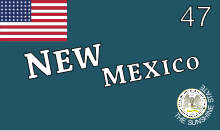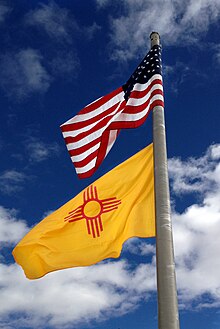 | |
| Use | Civil and state flag |
|---|---|
| Proportion | 2:3 |
| Adopted | March 15, 1925; 99 years ago (1925-03-15) |
| Design | The red and gold (yellow) of old Spain. The ancient Zia sun symbol in red on a field of yellow. |
| Designed by | Reba Mera |
The flag of the state of New Mexico, also referred to as the New Mexican flag, is a State flag, consisting of a sacred red sun symbol of the Zia tribe on a field of gold (yellow). It was officially adopted in March 15, 1925, to highlight the state's Indigenous and Hispanic heritage: it combines the symbol of Puebloan people, who have ancient roots in the state, with the colors of the flag of Spain, symbolizing the Spanish empire, which had established and ruled over “Nuevo México” for over two and a half centuries.
The New Mexico flag is among the most unique and iconic in the U.S., and has been noted for its simple and aesthetically pleasing design. It is one of four U.S. state flags without the color blue (along with Alabama, California, and Maryland) and the only one among the four without the color white. New Mexico is one of only two U.S states (along with Oklahoma) that depicts indigenous iconography in its flag.
The proportions of the symbol are fixed by New Mexico law: the four groups of rays are set at right angles, with the two inner rays one-fifth longer than the outer rays, and the diameter of the circle in the center is one-third the width of the symbol.
History


First flag


During its first thirteen years as a state, New Mexico did not have an official flag. The San Diego World's Fair of 1915, which occurred three years after New Mexico's admission to the union, featured an exhibit hall where all U.S. state flags were displayed; lacking an official flag, New Mexico displayed an unofficial one designed by Ralph Emerson Twitchell, the mayor of the state capital, Santa Fe. Known as the "Twitchell flag", it consisted of a blue field with the U.S. flag in the upper left corner, the words "New Mexico" in silver lettering in the center of the flag, the number "47" in the upper right corner (in reference to New Mexico being the 47th state), and the state seal in the bottom right corner (which in some historical references is wrapped with the words "The Sunshine State"). As of 2005, the only known Twitchell flag in existence was displayed at the Palace of the Governors in Santa Fe.
Second flag (1925–present)
1920 redesign
In 1920, the New Mexico chapter of the Daughters of the American Revolution (DAR) called for the creation of an official flag that would reflect the state's unique heritage and culture. A statewide contest was held in 1923 to solicit new designs. Eventually, a design made by Harry Mera of Santa Fe and sewn by his wife Reba Mera was selected. In 1925, Governor Arthur T. Hannett signed legislation proclaiming the Mera design the official state flag, which remains in use and unchanged to this day.
Mera was a physician and archaeologist who was familiar with the Zia sun symbol, initially found at Zia Pueblo on a 19th century pottery jar (which was later revealed to have been taken from a tribal secret society by James and Matilda Stevenson in the 1890s). The symbol has sacred meaning to the indigenous Zia people. Four is a sacred number symbolizing the Circle of Life: the four directions, the four times of day, the four stages of life, and the four seasons; the circle binds these four elements of four together.
The symbol was used without the permission of the Zia people, and they have fought to prevent it from being used without their permission, including via attempting to copyright it, during and after its adoption as a symbol of the state, and due to concerns over desecration of the symbol. A 2012 joint memorial by the state and the Zia people later acknowledged the state had appropriated the image without permission. Due to its longstanding use, the symbol is now unlikely to be eligible for copyright, falling into the American public domain, which remains a point of contention between the state and the Zia people, as the tribe was unaware of the specifics of such laws at the time the symbol was co-opted.
The salutation, "I salute the flag of the State of New Mexico and the Zia symbol of perfect friendship among united cultures", is commonly recited in New Mexico public schools after the United States pledge of allegiance.
The New Mexico flag was rated first in a 2001 survey of 72 U.S. and Canadian flags by the North American Vexillological Association.
Adoption
The flag is officially defined in law as:
That a flag be and the same is hereby adopted to be used on all occasions when the state is officially and publicly represented, with the privilege of use by all citizens upon such occasions as they may deem fitting and appropriate. Said flag shall be the ancient Zia sun symbol of red in the center of a field of yellow. The colors shall be the red and yellow of old Spain. The proportion of the flag shall be a width of two-thirds its length. The sun symbol shall be one-third of the length of the flag. Said symbol shall have four groups of rays set at right angles; each group shall consist of four rays, the two inner rays of the group shall be one-fifth longer than the outer rays of the group. The diameter of the circle in the center of the symbol shall be one-third of the width of the symbol. Said flag shall conform in color and design described herein.
— New Mexico Statutes and Court Rules, Section 12-3-2
The flag is worn on uniforms by sailors aboard the submarine USS New Mexico (SSN-779).
Pledge

The pledge to the state flag is available in English and Spanish:
I salute the flag of the state of New Mexico, the Zia symbol of perfect friendship among united cultures.
— New Mexico Statutes and Court Rules, Section 12-3-3
Saludo la bandera del estado de Nuevo México, el símbolo zia de amistad perfecta, entre culturas unidas.
— New Mexico Statutes and Court Rules, Section 12-3-7
See also
Notes
- The flag of the District of Columbia also has no blue, although it is partially white, making the New Mexico flag the only U.S. flag without blue or white.
- The Massachusetts and Florida flags contain state seals depicting Native people.
References
- ^ The Flag Book of the United States by Whitney Smith (1970), p. 174.
- ^ "State Flag". New Mexico Secretary of State. Retrieved August 27, 2022.
- ^ Edward B. Kaye (June 10, 2001). "2001 State/Provincial Flag Survey" (PDF). North American Vexillological Association.
- "flag of New Mexico | United States state flag | Britannica". www.britannica.com. Retrieved December 2, 2022.
- "List of US state flags and territories". ballotpedia.org. Retrieved January 11, 2021.
- ^ "State Flag | Maggie Toulouse Oliver - New Mexico Secretary of State". Retrieved December 2, 2022.
- ^ Nathanson, Rick. "New Mexico Flag Hasn't Always Had a Zia Symbol; Earliest Version Boasted Quartz Crystals". Archived from the original on March 4, 2021.
- ^ Nathanson, Rick (June 14, 2005). "Banner History". Albuquerque Journal. ProQuest 324325677. Retrieved January 11, 2023.
- "Early New Mexico Flag (U.S.)". www.fotw.info.
- "New Mexico (U.S.)". www.crwflags.com.
- "Zia's Symbol, New Mexico's Flag". El Palacio. 2012. Retrieved April 20, 2023.
- Harlow, Olivia (March 3, 2019). "How a sacred emblem became New Mexico's state symbol". Durango Herald. Retrieved April 20, 2023.
- "Indigenous Knowledge Misappropriation: The Case Of The Zia Sun Symbol Explained At WIPO". Intellectual Property Watch. December 11, 2018. Retrieved April 20, 2023.
- Montoya, Stephen (December 27, 2018). "Using the Zia symbol - with permission". Albuquerque Journal. Retrieved April 20, 2023.
- Edward B. Kaye (2001). "Good Flag, Bad Flag, and the Great NAVA Flag Survey of 2001". Raven: A Journal of Vexillology. 8: 11–38. doi:10.5840/raven200182.
- "Section 12-3-2", New Mexico Statutes and Court Rules, State of New Mexico
- "Fast-attack Submarine USS New Mexico (SSN 779) Virtual Tour". YouTube. November 8, 2020.
- "Section 12-3-3", New Mexico Statutes and Court Rules, State of New Mexico
- "Section 12-3-7", New Mexico Statutes and Court Rules, State of New Mexico